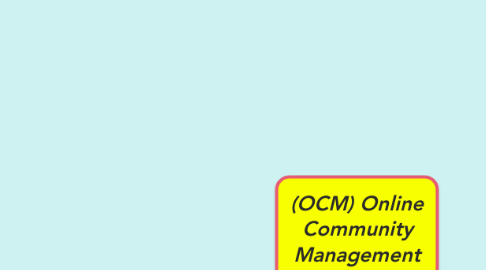
1. PLATFORM
1.1. KEY USES FOR ONLINE COMMUNITY PLATFORMS
1.1.1. Ideation processes
1.1.2. Social networking (private)
1.1.3. Self-help, peer-to-peer, expert advice support community
1.1.4. Opportunity to gauge customer satisfaction
1.1.5. Increase community engagement and interactions
1.1.6. Distribute relevant news and industry/company updates
1.1.7. Community blogging
2. Analytics
2.1. Unique users
2.2. Average number of responses per post
2.3. Average number of posts per day
2.4. Number of new threads per month - average and no average
2.5. What is the top discussion group?
2.6. Message orientation type
2.6.1. important metrics
2.6.1.1. Share your metric reports internally amongst your staff.
2.6.1.2. Share some stats that even the community members may find interesting.
3. OCP &STRATEGIES
3.1. Select your platform.
3.2. Identify your audience.
3.3. Understand what content your audience wants to see.
3.4. Determine your KPIs.
3.5. Ensure that your goals are set SMART.
3.5.1. Increase awareness.
3.5.2. Enhance public perception.
3.5.3. Solidify customer service/support.
3.5.4. Customers are increasingly turning to online channels to spread the word and request assistance. Be where your customers are!
3.5.5. Create brand advocates.
3.5.6. Gather feedback data.
3.5.7. Educate and inform new and existing customers.
3.6. Keep your postings consistent and regular.
3.7. Measure your results.
3.8. policies & procedures
3.8.1. Set community rules, regulations, and guidelines.
3.8.2. Check-in on your community regularly.
3.8.3. Be authentic (still a part of policy and procedure).
3.8.4. Listen - social listening.
3.8.5. Appreciate.
3.8.6. Maintain a consistent brand voice.
4. Policies & Procedure
4.1. Set community rules, regulations, and guidelines.
4.2. Check-in on your community regularly.
4.3. Be authentic (still a part of policy and procedure).
4.4. Listen - social listening.
4.5. Appreciate.
4.6. Maintain a consistent brand voice.
5. PROCESS
5.1. The good managers’ tools
5.2. Prior to launch, it is important to keep your community private until ready.
5.3. Another process would be to pre-define your community management team's roles.
5.3.1. Account for Terms of Service/Community Guidelines
5.3.1.1. PROCEDURES
5.3.1.1.1. Engage your community.
5.3.1.1.2. Give your passionate fans influence.
5.3.1.1.3. Be approachable.
5.3.1.1.4. Create conversations.
6. RULES & Responsibilities
6.1. Set Metrics for Success
6.2. Monitor Online Activity Closely
6.3. Encourage Networking
6.4. Initiate Discussion
6.5. Add Personality to the Conversation
6.6. Host Regular Video "Conferences" or Webinars
6.7. Cultivate Stories
7. Importance
7.1. Manage customer complaints
7.2. Turn customers into loyal fans
7.3. Win over influencers and prospective customers
7.4. Network with other brands and partner with them
7.5. Get valuable, raw product feedback
7.6. Be the coolest voice in a comments section.
7.6.1. OCM Parts
7.6.1.1. Monitoring
7.6.1.2. Engaging
7.6.1.3. Moderating
7.6.1.4. Measuring

